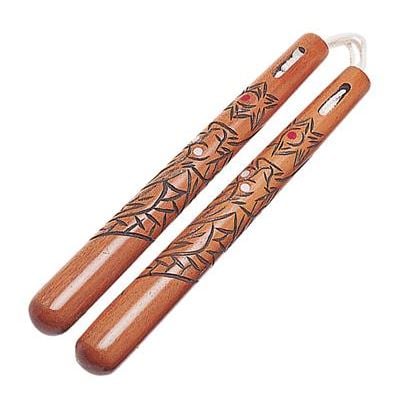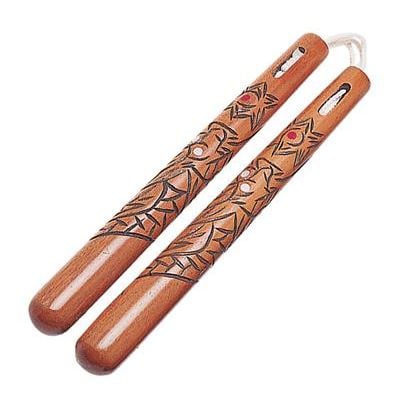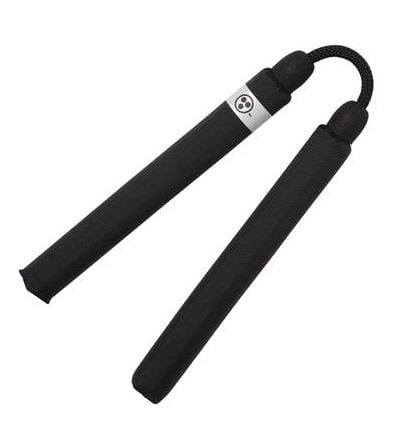
So, you’ve decided to start learning how to use the nunchaku! Good choice. It’s one of the most fun and versatile martial arts weapons, and it’s great for competition or simply learning for fun and twirling around your desk at work and nearly hitting your coworker in the skull (Ren, I am looking at you). Whatever your goals, you’ll get the best experience if you have the right gear.
In order to choose the right nunchaku, you need to first understand yourself. This might sound like a weird way to shop for martial arts equipment, but it is actually quite important. Nunchaku can be used for a variety of styles of martial arts, so different types exist. Additionally, it is a good idea to consider your personal physical build as well as your experience in using nunchaku. Once you know which nunchaku styles to look for, you can more easily find the perfect pair!
Solid Grip and the Right Length
The average length of a nunchaku is 12 inches (for one of the sticks), but they can vary from eight to 14 inches depending on the intended use and materials. To test which size is best for your body, hold the nunchaku firmly at the end closest to the connecting chain or rope. Without letting go, hold the nunchaku along the length of your forearm. If the nunchaku reaches your elbow, then it is an appropriate length for you to use.
The grip should feel comfortable in your hand as well, so it is a good idea to lightly test the weight and grip of the nunchaku. Nunchaku can be round or octagonal. Some people feel that the angles of the octagon nunchaku give them a better grip; others hate how it feels and swear that round ‘chucks are easier to manipulate for tricks. There’s no wrong style to go with (unless your instructor specifies that you need a certain kind) – it’s all a matter of preference! If you have the chance, test both octagon and round nunchaku out before buying and see which suits you.
A Range of Materials
Wood nunchaku are some of the most common nunchaku styles, coming in an assortment of different kinds of wood. Light woods are recommended for most training, since they can provide the speed and impact of heavier woods with less risk of damage to the martial artist, the target and the nunchaku itself. Experienced martial artists, however, may prefer heavy wood.
 Some nunchaku, like the red wood Corded Dragon Nunchaku, also feature designs!
Some nunchaku, like the red wood Corded Dragon Nunchaku, also feature designs!
For beginners, there are also plastic or PVC nunchaku are available for those first starting to learn martial arts. There are also foam nunchaku, which are great for kids and also thankfully the kind Ren has at his desk (I still haven’t forgotten the computer monitor incident, Ren).
 The Actionflex Nunchaku are some of the best padded nunchaku to get.
The Actionflex Nunchaku are some of the best padded nunchaku to get.
Aluminum and graphite nunchaku also exist. Because these are lightweight, they are primarily used for sport karate and demonstration purposes. If you’ve even watched someone like Danny Etkin of Team Paul Mitchell Karate compete, you can see just how fast some lightweight nunchaku move. These nunchaku often feature reflective or holographic tape or another decorative coating.
(Pssst – check out the nunchaku he’s using!)
A Durable Connection
Rope (in Japanese, “himo”) is the traditional material for joining the nunchaku, but it can wear away over time. Chain connections, or “kusari,” are a more modern addition, but it may take someone used to himo more time to adjust to the way the chain makes the nunchaku spin.
Professionals often do not consider one type of connection to be better than the other, just different. Therefore, testing each connection on a personal level in whichever martial art you intend to practice is a great way to see whether the flexibility of rope or the weight of chain is better for your preferences.
A Balancing Test
Just as you need to know how to properly balance your body in the practice of your martial art, the same goes for your nunchaku. Check the balance of your nunchaku by resting them in the center of your palm in a perpendicular direction to the ground. Nunchaku which are balanced correctly will pull the weight of the sticks to the outer edges. Unbalanced nunchaku can throw off an otherwise well-executed move.
Channel Your Inner Bruce Lee
No matter your skill level with nunchaku, it can be so important to choose the right weapon. The wrong size or material can lead to disaster, even in the hands of a professional. In additional to consulting with your martial arts teacher or mentor for how to choose equipment, researching a solid nunchaku guide on your own in an effort to understand the complexities of nunchaku styles is a smart idea. You can soon be on your way to picking the right nunchaku for your martial arts needs.

